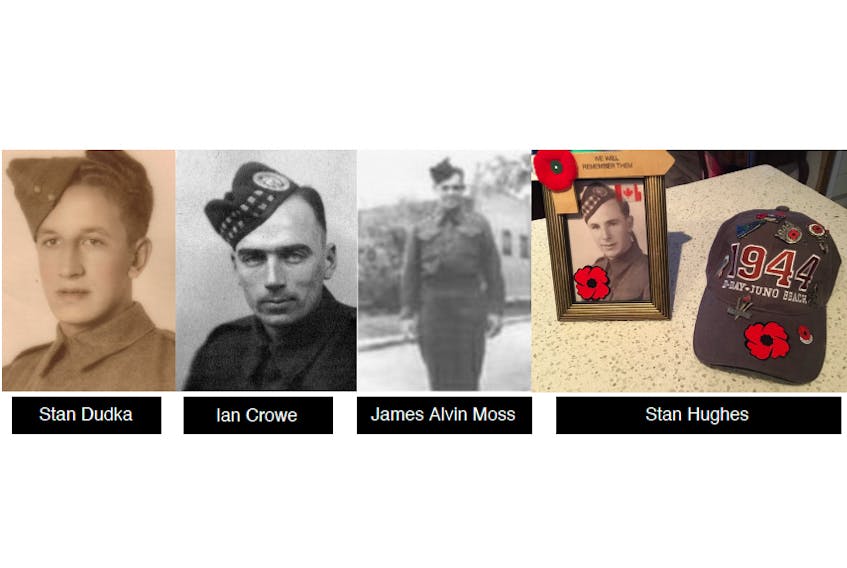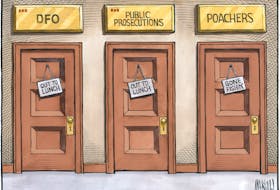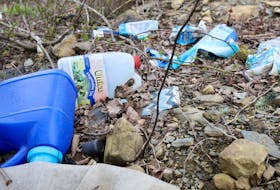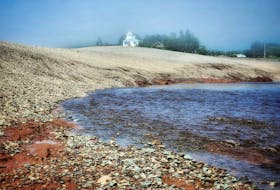By Lori Covelli
Special to The News
This year marked the 75th anniversary of the D-Day Invasion of Normandy (with our Canadian troops landing on Juno Beach). Interestingly, a vast number of Canadians are unfamiliar with the very horrendous execution of Canadian soldiers on D-Day Plus One, June 7, 1944.
It would be the day that two young soldiers from Stellarton and nearby Churchville, namely Sgt. Stanley Dudka and Sgt. Stanley Hughes, my beloved father, endured excruciating anguish and heartbreak as they witnessed first-hand several of their comrades and two childhood friends, Pte. Ivan Crowe of New Glasgow, and Pte. James Alvin Moss of Stellarton, being viciously massacred by enemy forces.
The Ardenne Abbey near Caen, France, was classified as a historical monument in 1918, the year my father was born. Just 26 years later, it came harrowingly close to being his place of execution.
Around the year 1121, a young man and his wife from Caen, France, worked for charity causes, and one day they had a vision of the Virgin Mary ordering them to build a chapel. They acquired seven acres of land and in time, a chapel was indeed erected. Many years would pass and over time the Abbey would house the White Canons, a religious order of the Roman Catholic Church. Sadly, on June 7, 1944, the Ardenne Abbey and vicinity served as the headquarters (within clear sight of any approaching enemy) for Kurt Meyer, Commander of the 12th SS Panzer Division of Hitler’s Youth.
Known for their extremist brutal mentality, these youthful Panzer warriors, born around 1926, were trained like no other division, to be as ferocious as possible. En route to Normandy in April of 1944, the Panzers already cold bloodily executed 85 innocent Frenchmen with not an ounce of mercy. Now these troops were settled in at their ideal location at the Ardenne Abbey. Meanwhile, Stan Dudka and Stan Hughes landed on D-Day June 6, 1944, at Juno Beach in Normandy. That very day my dad was glazed by a bullet to his temple as he attended to a dying comrade on the beach. As dusk settled in, the men would hide in a pigsty, not realizing that on D-Day Plus One, June 7th, their innocence of youth would be forever gone.
At daybreak Stan Hughes and Stan Dudka and their division headed toward The Ardenne Abbey. They ran smack into the worst enemies of war, Hitler’s Youth, who were waiting in the orchard of the Abbey. The unimaginable became a cruel reality that forever marred their lives. Here Meyer had seen the Canadians approaching unaware that German forces awaited.
On three sides, Meyer’s forces attacked with heavy support from Mark IV’s and Mark V’s armoured tanks that withstood the shells of the 27th Armoured Regiment, whose shells bounced off the powerful enemy’s tanks. Even the German guns 105 mm and 150 mm were heavier and had much longer range, and easily set the Sherman tanks of the Allies ablaze. The FOO support from the 14th Field Regiment that was supposed to move ahead with the North Nova Scotians and the 27th Armoured Regiment failed to find adequate positions of observation; when called upon for defensive fire, the Canadians were told they were on their own as guns were out of range. Even radio contact failed them. So as allied fire support went silent at critical moments, the Canadians received heavy German artillery fire and the NNSH
and the CAR troops found themselves out in the open and unsupported, surrounded by the enemy.
The bloody battlefield ensued for several hours and towards the end, the Allied forces, stripped of their heavy tanks, fought valiantly only with their handheld weapons. Heavy casualties on both sides were near equal. But the failure of Canadian artillery impacted their success and the Allies were captured and bought to The Abbey. Absolute fear must have set in for these North Nova Scotia Highlanders and the 27th Canadian Armed Regimental troops. They were forced at gunpoint to line up one behind the other and told to expose their pocket contents (looking for ammunition and documentation). My dad, Stan Hughes, said he told them in German, ‘das bonbons’ re the candy he received from the Red Cross in exchange for cigarettes.
The German commander requested 10 volunteers to step forward. Our brave Canadian soldiers stood defiant and united. Literally shaking in their boots, each soldier was then randomly selected, and led to the back of the chapel and either shot at point blank range to the head or by blunt force of a rifle. As each left, those soldiers one by one would turn to a comrade and shake their hand, and each held their head high even as they faced such a crude death.
Dad recalled that the two soldiers directly ahead of him and the three directly behind him were all executed. On that terrible day in history, 18 young men in their prime fighting for freedom, died heroes. Maybe Stan Hughes did indeed have the luck of the Irish (his ancestry) as the odds were against his survival.
Both Stan Dudka and my dad, Stan Hughes, survived the massacre, but not without the mental anguish that would haunt them for years to come. I am sure that Stan Dudka’s parents probably received the same notification as my dear grandparents – “Missing in Action and Presumed Dead.”
Dad became a prisoner of war for the next 11 months and endured unthinkable perils of war. Stan Dudka was also a POW and escaped, only to be recaptured. Even with serious injury, he successfully escaped on his third attempt. Thankfully with his expertise, he was able to rejoin the fight with more determination to win the battle and freedom. I cannot imagine two soldiers named Stanley … both survived D-Day on Juno Beach, both were tortured as prisoners of war but survived, and both narrowly by the grace of God, escaped death at The Abbey! Can you imagine the tight, teary-eyed embrace when these two local boys saw each other again?
Under the Geneva Convention, it was illegal to mistreat prisoners of war, nevermind kill them. The Canadian War Crimes Committee investigated for a year and Kurt Meyer was bought to trial in late 1945 for purposely ordering his troops to murder POWs. About 156 Canadians were killed under his command in and around The Abbey, rather than being taken prisoners.
Sgt. Dudka had to verbally relive the events at The Abbey, but doing so, he was instrumental as a witness and greatly aided in Meyer being given the death sentence. A year later, the sentence was overturned, and Meyer was given a life sentence. Then in 1954, he was one of the last German war criminals to be released from prison. He denied any involvement during his trial, but during a revisit to the Abbey, he admitted he did give orders for the death of these young Canadian soldiers.
Meyers died in 1961, but did he ever suffer the consequences of his actions? Did he ever have nightmares of the crimes he ordered? Stan Dudka must have endured incredible unspeakable memories of both the war and the trial. As a daughter of Stan Hughes, my dad would break down in tears at the Christmas dinner table, feeling incredible guilt that he was a survivor and others were not. Too often, I would witness in the still of the night, my dad running down the hallway screaming, “The Germans are coming” as he knelt terrified in a corner, awakening again from yet another terrible nightmare!
On this Remembrance Day, may we not only remember each soldier who gave the ultimate sacrifice, but also those who fought and came home. It is important to honour our hometown heroes as some of the bravest who volunteered to fight for freedom. May their families be so very proud of their heroism at The Abbey.
Ian Crowe and James Alvin Moss, both age 22, were buried in war cemeteries in France. Stan Dudka and Stan Hughes went on to raise large families. Sgt. Dudka was decorated with the Military Medal for distinguished service at Buckingham Palace. Stan Hughes returned to The Ardenne Abbey, a very difficult experience to honour his comrades.
Stan Hughes will forever be my hero. I was blessed to inherit his humour, his love of country and unselfishness, he named me after The Cross of Lorraine, and as he and I alone, spent endless hours hauling logs, he taught me every single army song ever written! On Remembrance Day, I raise a toast to our local heroes Ian Crowe, James Moss, Stan Dudka and Stan Hughes and all their comrades. Enjoy an extra beer and belt out those old army songs.
Love you endlessly dad, Buttons!
A memorial was erected in June 1984 at The Abbey in respect to the Canadian soldiers who died there on June 7 to June 8, 1944.
Pte. Ivan Lee Crowe of New Glasgow. NNSH
Pte. Charles Doucette of Sydney. NNSH
Pte. Reginald Keeping of Newfoundland. NNSH
Cpl. Joseph Francis MacIntyre of Sydney Mines. NNSH
Pte. James Alvin Moss of STELLARTON. NNSH
Pte. Walter Michael Doherty of New Brunswick. NNSH
Pte. Hollis Leslie McKeil of Lower Selma’s, Nova Scotia. NNSH
Pte. Thomas Edward Mont of Truro. NNSH
Pte. Raymond Moore of Kentville. NNSH
Pte. George Edward Millar of Ontario. NNSH
Pte. George Richard McNaughton of Sydney. NNSH
Pte. Hugh Allen MacDonald of Morgan, Nova Scotia. NNSH
Tpr James Bolt of Ontario Canadian Armoured Regiment
Tpr George Gill of England. CAR
Tpr Thomas Halliburton Henry of Montreal. CAR
Tpr Roger Lockhead of Montreal. CAR
TPR Harold George Philp of Ontario. CAR
Ltn. Thomas Alfred Lee Windsor of Montreal.









